|
News Archive: Oct. 1-31 |

|
NASA gives 'go' for Hubble servicing mission
NASA Administrator Michael Griffin has approved a fifth and final shuttle mission to service the Hubble Space Telescope. The flight will extend the observatory's life by replacing aging parts and increase its scientific reach by installing two new instruments. Launch is tentatively planned for May 2008 using shuttle Discovery.
 FULL STORY - updated! FULL STORY - updated!
 PREVIEW STORY PREVIEW STORY
 SPACE SHUTTLE MANIFEST SPACE SHUTTLE MANIFEST
 VIDEO: LAUNCH OF HUBBLE VIDEO: LAUNCH OF HUBBLE
 |  |

|
 |

Additional coverage for subscribers:
 VIDEO:
DETAILS ON SERVICING PLAN AND SCIENCE INSTRUMENTS PLAY VIDEO:
DETAILS ON SERVICING PLAN AND SCIENCE INSTRUMENTS PLAY
 VIDEO:
MEET THE MISSION'S ASTRONAUTS DIAL-UP | BROADBAND VIDEO:
MEET THE MISSION'S ASTRONAUTS DIAL-UP | BROADBAND
 SUBSCRIBE NOW SUBSCRIBE NOW

|
Just a few more days to send your name with Dawn
NASA's campaign to send the nom de plumes of people from around the world into the heart of the asteroid belt ends Saturday. Submitted names will be carried on board Dawn, the first spacecraft to travel between and scrutinize the asteroid Vesta and dwarf planet Ceres.
 FULL STORY FULL STORY
 |  |

|
 |
Shuttle moves to VAB
Space shuttle Discovery made an evening move from its hangar to the Vehicle Assembly Building where the ship will be mated to the external fuel tank and twin solid rocket boosters. The transfer had been targeted for noon EST Tuesday, but was delayed to finish work on the landing gear. The 35-minute trip began at 9:23 p.m. The shuttle stack is scheduled for rollout to launch pad 39B next Tuesday in preparation for liftoff December 7.
 |  |

|
 |
The spooky sun
Just in time for Halloween, astronomers have taken a haunting new portrait of the sun. In this color-coded image from the Hinode spacecraft, the sun glows eerily orange as though celebrating with earthly spooks.
 FULL STORY FULL STORY
 |  |

|
 |
Next shuttle mission to
re-wire the space station
Shuttle astronauts, flight controllers and space station engineers are in the final stages of training for a complex multi-spacewalk mission in December to conduct electronic bypass surgery on the orbital lab complex and activate its main power and cooling systems.
 FULL STORY FULL STORY
 MISSION QUICK-LOOK MISSION QUICK-LOOK
 MASTER FLIGHT PLAN MASTER FLIGHT PLAN
 |  |

|
 |
NASA announces new mission candidates
NASA Monday selected concept studies for missions that would return a sample of an enigmatic asteroid, probe the chemistry of Venus' atmosphere and reveal the interior structure and history of the Earth's moon.
 FULL STORY FULL STORY
 |  |

|
 |
Sea Launch lofts craft for XM Satellite Radio
The fourth broadcasting spacecraft for XM Satellite Radio, nicknamed Blues, successfully ascended to orbit Monday atop a rocket launched from a floating pad in the Pacific Ocean.
 MISSION STATUS CENTER MISSION STATUS CENTER
 |  |

|
 |
Greenland ice sheet on a downward slide
For the first time NASA scientists have analyzed data from direct, detailed satellite measurements to show that ice losses now far surpass ice gains in the shrinking Greenland ice sheet.
 FULL STORY FULL STORY
 |  |

|
 |
Superb view of Janus
The Cassini spacecraft provides this dramatic portrait of Janus against the cloud-streaked backdrop of Saturn. Like many small bodies in the solar system, Janus is potato-shaped with many craters, and the moon has a surface that looks as though it has been smoothed by some process. It may be covered with a mantle of fine dust-sized, icy material.
 FULL STORY FULL STORY
 |  |

|
 |
Dione's creeping canyons
Bright fractures creep across the surface of icy Dione, one of Saturn's moons. This extensive canyon system is centered on a region of terrain that is significantly darker that the rest of the moon. Part of the darker terrain is visible at right.
 FULL STORY FULL STORY
 |  |

|
 |
Spitzer peels back layers of star's explosion
Astronomers using NASA's infrared Spitzer Space Telescope have discovered that an exploded star, named Cassiopeia A, blew up in a somewhat orderly fashion, retaining much of its original onion-like layering.
 FULL STORY FULL STORY
 |  |

|
 |
Resupply vessel latched to station after delay
A Russian Progress supply ship loaded with oxygen and critical supplies docked with the international space station Thursday. The final "hard mate" was delayed two orbits or so for troubleshooting to make sure an antenna on the cargo craft had retracted properly.
 FULL STORY FULL STORY
 LAUNCH STORY LAUNCH STORY
 |  |
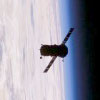
|
 |
Spacecraft launched to see the sun in a new dimension
NASA launched a pair of compact spacecraft Wednesday night that will use the moon's gravity to whip them into orbital positions ahead of and behind the Earth to study titanic solar eruptions in 3-D.
 FULL STORY FULL STORY
 MISSION STATUS CENTER MISSION STATUS CENTER
 IMAGES: LAUNCH OF STEREO IMAGES: LAUNCH OF STEREO
 IMAGES: SERVICE TOWER ROLLBACK IMAGES: SERVICE TOWER ROLLBACK
 LAUNCH EVENTS TIMELINE LAUNCH EVENTS TIMELINE
 GROUND TRACK MAP GROUND TRACK MAP
 |  |

|
 |

Additional coverage for subscribers:
 VIDEO:
THE FULL LAUNCH EXPERIENCE PLAY VIDEO:
THE FULL LAUNCH EXPERIENCE PLAY
 VIDEO:
LAUNCH OF STEREO ABOARD DELTA 2 ROCKET PLAY VIDEO:
LAUNCH OF STEREO ABOARD DELTA 2 ROCKET PLAY
 VIDEO:
POST-FLIGHT REPORT FROM LAUNCH MANAGER PLAY VIDEO:
POST-FLIGHT REPORT FROM LAUNCH MANAGER PLAY
 VIDEO:
LAUNCH DAY ROLLBACK OF PAD'S SERVICE TOWER PLAY VIDEO:
LAUNCH DAY ROLLBACK OF PAD'S SERVICE TOWER PLAY
 VIDEO:
NARRATED MOVIE OF DELTA ROCKET PRE-LAUNCH FLOW PLAY VIDEO:
NARRATED MOVIE OF DELTA ROCKET PRE-LAUNCH FLOW PLAY
 VIDEO:
NARRATED MOVIE OF STEREO PRE-LAUNCH PROCESSING PLAY VIDEO:
NARRATED MOVIE OF STEREO PRE-LAUNCH PROCESSING PLAY

 VIDEO:
STEREO PRE-LAUNCH NEWS BRIEFING DIAL-UP | BROADBAND VIDEO:
STEREO PRE-LAUNCH NEWS BRIEFING DIAL-UP | BROADBAND
 VIDEO:
MISSION SCIENCE PREVIEW DIAL-UP | BROADBAND VIDEO:
MISSION SCIENCE PREVIEW DIAL-UP | BROADBAND
 VIDEO:
DELTA ROCKET'S NOSE CONE INSTALLED FOR LAUNCH PLAY VIDEO:
DELTA ROCKET'S NOSE CONE INSTALLED FOR LAUNCH PLAY
 VIDEO:
SATELLITES SEEN MOUNTED ATOP ROCKET PLAY VIDEO:
SATELLITES SEEN MOUNTED ATOP ROCKET PLAY
 VIDEO:
SPACECRAFT DELIVERED TO LAUNCH PAD PLAY VIDEO:
SPACECRAFT DELIVERED TO LAUNCH PAD PLAY
 MORE: STEREO VIDEO COVERAGE MORE: STEREO VIDEO COVERAGE
 SUBSCRIBE NOW SUBSCRIBE NOW

|
Second modernized GPS satellite begins service
The second modernized Global Positioning System Block 2R satellite, designed and built by Lockheed Martin has been declared fully operational for military and civilian navigation users around the globe.
 FULL STORY FULL STORY
 LAUNCH COVERAGE LAUNCH COVERAGE
 |  |
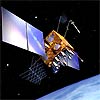
|
 |
Study: Space radiation threats to astronauts
A better understanding of solar storms and how best to protect astronauts from space radiation is needed as NASA pushes toward manned missions to the moon and Mars in the coming decades, according to a new National Research Council report.
 FULL STORY FULL STORY
 |  |

|
 |
MESSENGER spacecraft completes Venus flyby
NASA's Mercury-bound MESSENGER spacecraft came within 1,860 miles of the surface of Venus early Tuesday morning during its second planetary encounter. The spacecraft used the tug of the planet's gravity to change its trajectory significantly, shrinking the radius of its orbit around the Sun and bringing it closer to Mercury.
 FULL STORY FULL STORY
 |  |
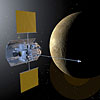
|
 |
"Build it and infrared surprises will come"
Engineers are rolling up their sleeves in preparation for building a telescope that will find the nearest star-like objects and the brightest galaxies. NASA has approved the start of construction on a new mission called the Wide-field Infrared Survey Explorer, which will scan the entire sky in infrared light.
 FULL STORY FULL STORY
 |  |

|
 |
Planet hunters wanted to search for new worlds
Astronomers at the University of California, Santa Cruz, are seeking the public's help to find and understand planets outside our solar system. But you don't need an advanced degree or even a telescope to participate -- just a computer, access to the Internet, and an interest in astronomy.
 FULL STORY FULL STORY
 |  |

|
 |
Cosmic bubble image wins observatory contest
A striking image of an enormous bubble blown into the dusty gas disk of our own Milky Way galaxy has won first place in the National Radio Astronomy Observatory's second annual Radio Astronomy Image Contest.
 FULL STORY FULL STORY
 |  |

|
 |
OTHER HEADLINES Additional stories today
|
 |
JPL director named one of 'America's Best Leaders' -- Dr. Charles Elachi, director of NASA's Jet Propulsion Laboratory in Pasadena, Calif., is being honored as one of "America's Best Leaders" by U.S. News & World Report, in collaboration with the Center for Public Leadership at Harvard University's John F. Kennedy School of Government.

Air Force honors DSCS satellite program -- The U.S. Air Force has named the Defense Satellite Communications System (DSCS) Life Extension Team as a winner of the 2006 Chief of Staff Team Excellence Award. The prestigious award recognizes outstanding team performance and shares best practices within the Air Force.
|
 |
Cargo ship begins flight to the space station
A freighter packed with fresh supplies and critical repair parts for the International Space Station successfully rocketed away from Earth today and immediately began plotting a three-day trek to the orbiting outpost.
 UPDATED STORY UPDATED STORY
 |  |

|
 |
Partly cloudy skies forecast for Delta launch
Twin solar observatories designed to create 3-D images of the sun are scheduled for launch Wednesday evening from Cape Canaveral aboard a Boeing Delta 2 rocket. The early weather outlook predicts excellent conditions for the 8:38 p.m. EDT liftoff.
 SEE FORECAST SEE FORECAST
 |  |
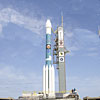
|
 |
Planet-finding by numbers
More than a decade after the first planets beyond our solar system were found, astronomers have discovered about 200 of these "extrasolar planets," as they're called. Using a common-sense definition of potentially habitable planets, coupled with extensive computer simulations, scientists have calculated how many potentially habitable planets might be detected around other stars by the SIM PlanetQuest mission.
 FULL STORY FULL STORY
 |  |

|
 |
Mars may be cozy place for hardy microbes
A class of especially hardy microbes that live in some of the harshest Earthly environments could flourish on cold Mars and other chilly planets, according to a research team of astronomers and microbiologists.
 FULL STORY FULL STORY
 |  |

|
 |
Antarctic ozone hole is a record breaker
NASA and National Oceanic and Atmospheric Administration scientists report this year's ozone hole in the polar region of the Southern Hemisphere has broken records for area and depth.
 FULL STORY FULL STORY
 |  |

|
 |
European weather satellite finally launches
Delayed five times since the summer, launch of Europe's first polar-orbiting weather observatory aboard a Russian Soyuz rocket finally occurred at 1628 GMT (12:28 p.m. EDT) Thursday from Baikonur Cosmodrome. The Soyuz's lower three stages completed their firings and the Fregat upper stage motor burned twice to propel the MetOp-A spacecraft into orbit for deployment about 68 minutes after liftoff. Officials have confirmed a successful launch.
 FULL STORY FULL STORY
 |  |
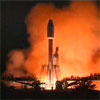
|
 |
No evidence of ice reserves on the moon
Alas, the moon is not for winter sports. Never mind the difficulty of a triple axel in a bulky spacesuit (though the diminished gravity might help) -- ice, it turns out, is hard to come by up there.
 FULL STORY FULL STORY
 |  |

|
 |
Astronomers nab culprit in galactic hit-and-run
The Andromeda galaxy, the closest large spiral to the Milky Way, appears calm and tranquil as it wheels through space. But appearances can be deceiving. Astronomers have new evidence that Andromeda was involved in a violent head-on collision with the neighboring dwarf galaxy Messier 32 (M32) more than 200 million years ago.
 FULL STORY FULL STORY
 |  |

|
 |
OTHER HEADLINES Additional stories today
|
 |
New insights into composition of giant planets -- Research by 2006 Urey Prize winner, Tristan Guillot of the Observatoire de la Cote d'Azur in Nice, provides new insights into the composition of giant planets.

NASA announces new International Space Station crew -- NASA and the Russian Federal Space Agency have named two astronauts and two cosmonauts to the next International Space Station crew, known as Expedition 15. Astronauts Clayton Anderson and Daniel Tani will travel to the station next year and work as flight engineers. Cosmonauts Fyodor Yurchikhin and Dr. Oleg Kotov will spend six months aboard the orbiting laboratory.

Boeing to build more Wideband Gapfiller Satellites -- Boeing and the U.S. Air Force MILSATCOM Systems Wing have signed a $1.067 billion contract for up to three more Wideband Gapfiller Satellites (WGS), if all options are exercised. The Block II satellites will be similar to the three Block I satellites already in production.
|
 |
Mars Express and the story of water on Red Planet
For a number of decades now, astronomers have wondered about water on Mars. Thanks to the European Space Agency's Mars Express, much of the speculation has been replaced with facts.
 FULL STORY FULL STORY
 |  |

|
 |
Colliding galaxies pictured in amazing Hubble picture
A new Hubble image of the Antennae galaxies is the sharpest yet of this merging pair of galaxies. As the two galaxies smash together, billions of stars are born, mostly in groups and clusters of stars. The brightest and most compact of these are called super star clusters.
 FULL STORY FULL STORY
 |  |

|
 |
Space shuttle launch schedule gets a makeover
NASA managers have proposed new launch dates for the first three shuttle missions of 2007. Planning dates for all remaining flights through the end of shuttle operations in 2010 also were updated based on preliminary launch processing assessments. While several near-term flights face delays due primarily to external tank deliveries and possible conflicts with Russian Soyuz launches, NASA still expects to meet its 2010 deadline for completing the station and retiring the shuttle.
 FULL STORY FULL STORY
 MANIFEST GRAPHIC MANIFEST GRAPHIC
 |  |

|
 |
Craft reveals new details of Mars, young and old
During its first week of observations from low orbit, NASA's newest Mars spacecraft is already revealing new clues about both recent and ancient environments on the planet.
 FULL STORY FULL STORY
 |  |

|
 |

Additional coverage for subscribers:
 VIDEO:
BRIEFING ON NEW MARS ORBITER PICTURES PLAY VIDEO:
BRIEFING ON NEW MARS ORBITER PICTURES PLAY
 SUBSCRIBE NOW SUBSCRIBE NOW

|
Some super-Earths form in cosmic 'snowstorms'
The 200 known planets that orbit other stars exhibit incredible variety. Among them are a handful of worlds that weigh between 5 and 15 times Earth. Astronomers believe these "super-Earths" are rocky iceballs rather than gas giants like Jupiter. While theorists can explain how such worlds form around Sun-like stars, the discovery of super-Earths around tiny red dwarf stars was surprising.
 FULL STORY FULL STORY
 |  |

|
 |
Orbiter reveals complex meteorology at Venus
In its relentless probing of Venus's atmosphere, the European Space Agency's Venus Express keeps revealing new details of the Venusian cloud system. Meteorology at Venus is a complex matter, scientists say.
 FULL STORY FULL STORY
 |  |

|
 |
Spitzer sees day and night on exotic world
NASA's Spitzer Space Telescope has made the first measurements of the day and night temperatures of a planet outside our solar system. The infrared observatory revealed that the Jupiter-like gas giant planet circling very close to its sun is always as hot as fire on one side, and potentially as cold as ice on the other.
 FULL STORY FULL STORY
 |  |

|
 |
Ariane 5 rocket launches international cargo
A heavy-lifting Ariane 5 rocket loaded with payloads from the U.S., Australia and Japan launched right on schedule at 2056 GMT (4:56 p.m. EDT) Friday from Kourou, French Guiana.
 MISSION STATUS CENTER - live updates MISSION STATUS CENTER - live updates
 LAUNCH INFO LAUNCH INFO
 |  |
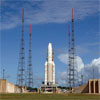
|
 |
Flies in a spider's web: Galaxy caught in the making
New Hubble images have provided a dramatic glimpse of a large massive galaxy under assembly as smaller galaxies merge. This has commonly been thought to be the way galaxies grew in the young Universe, but now Hubble observations of the radio galaxy nicknamed the "Spiderweb Galaxy" have shown dozens of star-forming satellite galaxies in the actual process of merging.
 FULL STORY FULL STORY
 |  |

|
 |
Original Mission Control revived for growing station
International Space Station flight controllers have a new home with increased technical capabilities, more workspace and a long, distinguished history.
 FULL STORY FULL STORY
 |  |

|
 |
OTHER HEADLINES Additional stories today
|
 |
ILS begins next launch campaign -- International Launch Services (ILS) kicked off its next Proton launch campaign this week with the arrival Tuesday of the satellite payload, Arabsat's BADR-4, at the Baikonur Cosmodrome.

ILS ownership changes -- Lockheed Martin Corporation's shares of International Launch Services were transferred Oct. 11 to Space Transport Inc. and the ILS Board of Directors appointed Frank McKenna, 53, as the company's president.
|
 |
NASA finds Saturn's moons may be creating new rings
Cassini scientists are on the trail of the missing moons of Saturn. A recent observation by the spacecraft leads them to believe that they will find the moons near newly discovered rings around the planet.
 FULL STORY FULL STORY
 |  |

|
 |
Rings show evidence of a modern-day collision
Scientists with NASA's Cassini mission have spied a new, continuously changing feature that provides circumstantial evidence that a comet or asteroid recently collided with Saturn's innermost ring, the faint D ring.
 FULL STORY FULL STORY
 |  |

|
 |
Cassini image shows Saturn draped in a string of pearls
Saturn appears dressed to the nines, "wearing" a strand of "pearls" in a stunning infrared image from the Cassini spacecraft that showcases a meteorological phenomenon.
 FULL STORY FULL STORY
 |  |

|
 |
Jupiter's Little Red Spot growing stronger
The highest wind speeds in Jupiter's Little Red Spot have increased and are now equal to those in its older and larger sibling, the Great Red Spot, according to observations with NASA's Hubble Space Telescope.
 FULL STORY FULL STORY
 |  |

|
 |
Station gyro off line; impact on shuttle flight assessed
One of the international space station's four control moment gyroscopes, used to keep the outpost properly oriented without jarring, fuel-consuming rocket firings, was taken off line late Monday because of concern about repeated instances of excessive vibration.
 FULL STORY FULL STORY
 |  |

|
 |
Station crew drives Soyuz to another docking spot
The three-man crew of the International Space Station took a short trip Tuesday, flying their Soyuz capsule from one docking port to another in preparation for receiving a resupply ship later this month.
 FULL STORY FULL STORY
 |  |

|
 |
Hubble confirms nearest known extrasolar planet
NASA's Hubble Space Telescope, in collaboration with ground-based observatories, has provided definitive evidence for the existence of the nearest extrasolar planet to our solar system. The Jupiter-sized world orbits the Sun-like star Epsilon Eridani, which is only 10.5 light-years away.
 FULL STORY FULL STORY
 |  |

|
 |
Chandra reviews black hole musical: Epic but off-key
A gigantic sonic boom generated by a supermassive black hole has been found with NASA's Chandra X-ray Observatory, along with evidence for a cacophony of deep sound.
 FULL STORY FULL STORY
 |  |

|
 |
'Chinese lantern' technique helps track clouds at Saturn
A new image of Saturn demonstrates a technique that creates a 'Chinese lantern' effect, showing Saturn's deep clouds silhouetted against the planet's warm, glowing interior. Seen this way, Saturn's interior shows surprising activity underneath the overlying haze, with a great variety of cloud shapes and sizes.
 FULL STORY FULL STORY
 |  |

|
 |
Swift performs headcount of local black holes
NASA scientists using the Swift satellite have conducted the first complete census of galaxies with active, central black holes, a project that scanned the entire sky several times over a nine-month period.
 FULL STORY FULL STORY
 |  |

|
 |
Planck to build on Nobel-prize-winning science
The 2006 Nobel Prize for physics has been awarded to Americans John C. Mather and George F. Smoot for their work on NASA's 1989 Cosmic Background Explorer (COBE) satellite. In 2008, ESA's Planck satellite will launch and build on this award-winning legacy by showing cosmologists new details of the Universe's origins.
 FULL STORY FULL STORY
 |  |

|
 |
Mars rover spotted at crater by sharp-eyed orbiter
NASA's long-lived robotic rover Opportunity is beginning to explore layered rocks in cliffs ringing the massive Victoria crater on Mars. While Opportunity spent its first week at the crater, NASA's newest eye in the Martian sky photographed the rover and its surroundings from above.
 FULL STORY FULL STORY
 |  |

|
 |

Additional coverage for subscribers:
 VIDEO:
THE NEW MARS PICTURES REVEALED PLAY VIDEO:
THE NEW MARS PICTURES REVEALED PLAY
 SUBSCRIBE NOW SUBSCRIBE NOW

|
Shuttles to resume night launches; Atlantis damaged
NASA managers met Thursday and agreed to relax a self-imposed post-Columbia daylight launch constraint, clearing the way for Discovery's evening liftoff Dec. 7 on a complex station assembly mission. It will be the first night shuttle launch since 2002. Meanwhile, engineers are assessing options for fixing a radiator on Atlantis apparently damaged when a piece of space debris or a micrometeoroid slammed into the panel.
 FULL STORY FULL STORY
 |  |
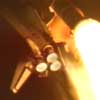
|
 |
Scientists nudge closer to the edge of a black hole
NASA scientists and their international partners using the new Japanese Suzaku satellite have collected a startling new set of black hole observations, revealing details of twisted space and warped time never before seen with such precision.
 FULL STORY FULL STORY
 |  |

|
 |
Determining the nature of black hole jets
NASA and Italian scientists using the Swift spacecraft have for the first time determined what the particle jets streaming from black holes are made of. The jets observed by Swift contain about the mass of Jupiter if it were pulverized and blasted out into intergalactic space.
 FULL STORY FULL STORY
 |  |

|
 |
Hubble finds extrasolar planets far across galaxy
NASA's Hubble Space Telescope has discovered 16 extrasolar planet candidates orbiting a variety of distant stars in the central region of our Milky Way galaxy. Five of the newly found planets represent a new extreme type of planet not found in any nearby searches.
 FULL STORY FULL STORY
 |  |

|
 |

Additional coverage for subscribers:
 VIDEO:
WATCH THE HUBBLE ANNOUNCEMENT PLAY VIDEO:
WATCH THE HUBBLE ANNOUNCEMENT PLAY
 SUBSCRIBE NOW SUBSCRIBE NOW

|
Survey of star explosions reveals key findings
Scientists using NASA's Swift satellite have observed two dozen recent star explosions, called supernovae, quickly after the event and have discovered never-before-seen properties, some of which run counter to prevailing theories.
 FULL STORY FULL STORY
 |  |

|
 |
FTC gives clearance to United Launch Alliance
United Launch Alliance, the joint venture between Lockheed Martin and Boeing, has received anti-trust clearance from the Federal Trade Commission. ULA would combine the production, engineering, test and launch operations associated with U.S. government launches of Atlas and Delta rockets.
 FULL STORY FULL STORY
 |  |

|
 |
Planets prefer safe neighborhoods
A star must live in a relatively tranquil cosmic neighborhood to foster planet formation, say astronomers using NASA's Spitzer Space Telescope. A team of scientists came to this conclusion after watching intense ultraviolet light and powerful winds from O-type stars rip away the potential planet-forming disks around stars like our sun.
 FULL STORY FULL STORY
 |  |

|
 |
Big Bang scientists win Nobel Prize for Physics
The Nobel Prize Committee announced Tuesday that NASA scientist John Mather and George Smoot of the Lawrence Berkeley National Laboratory are this year's recipients of the Nobel Prize for Physics. They received the award for their work that helped cement the Big Bang theory of the universe and deepened our understanding of the origin of stars and galaxies.
 NASA RELEASE NASA RELEASE
 BERKELEY RELEASE BERKELEY RELEASE
 |  |

|
 |
Hubble finds dark cloud in the atmosphere of Uranus
Just as we near the end of the hurricane season in the Atlantic Ocean, winds whirl and clouds churn 2 billion miles away in the atmosphere of Uranus, forming a dark vortex large enough to engulf two-thirds of the United States.
 FULL STORY FULL STORY
 |  |

|
 |
Stellar birth control in the early universe
An international team of astronomers based at Yale and Leiden University in The Netherlands found that "old stars" dominated many large galaxies in the early universe, raising the new question of why these galaxies progressed into "adulthood" so early in the life of the universe.
 FULL STORY FULL STORY
 |  |

|
 |
|
Read our earlier news archive page.
|



